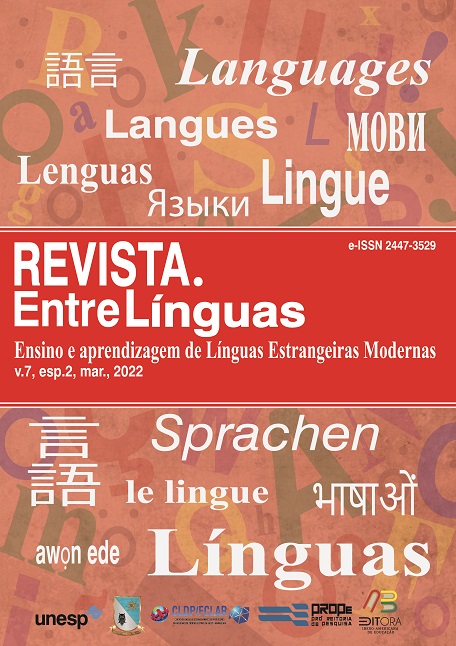The representation of nature and man in metaphors of Aipin’s works
DOI:
https://doi.org/10.29051/el.v8iesp.2.17309Keywords:
Anthropomorphic metaphor, Metaphor of nature, Linguistic worldview, Metaphorical schemeAbstract
This study analyzes the metaphors in such works of contemporary Khanty writer as Yeremei Aipin “Khanty, or the Morning Star Dawn” and “Mother of God in the Bloody Snows”. The metaphors under study reflect the essence of interaction of man and nature and are presented by the author in the form of metaphorical schemes. As a result of the study, the conclusion is made that in the minds of the characters presented in the author’s works, nature and man have a close connection, which is reflected in the use of metaphors that correspond to iconic cognitive schemes: the source sphere “nature” – the target sphere “man”, the source sphere “man” – the target sphere “nature”. The results can be applied in the regional studies, in teaching such courses as “Linguistic Worldview of the Small-numbered Peoples”, and in the works devoted to the creative writing style of Ye.D. Aipin.
Downloads
References
ABDYZHAPAROVA, M. I.; FEDOSOVA, T. V.; SOMIKOVA, T. Yu.; BARANOVA, I. V.; HARCHENKOVA, L. I. Types of anthropomorphic metaphor in IT discourse. Astra Salvensis, n. 1, p. 561-574, 2020. Available in: https://www.ceeol.com/search/article-detail?id=901821. Access in: 12 Feb. 2021.
AIPIN, E. The mother of God in the bloody snows. Yekaterinburg: Parkus, 2002.
AIPIN, E. Collected works: In 4 volumes. Vol. 1: At the dying hearth. St. Petersburg: Amphora, 2014a.
AIPIN, E. Collected works: in 4 volumes. Vol. 2: Khanty, or the Star of the Morning Dawn. St. Petersburg: Amphora, 2014b.
BURMAKOVA, E. A. Cognitive nature of anthropomorphic metaphor in artistic discourse. Language and culture, v. 3, n. 31, p. 28-36, 2015. Available in: http://journals.tsu.ru//language/&journal_page=archive&id=1311&article_id=24263. Access in: 12 Feb. 2021.
CHUDINOV, A. P. Cognitive-discursive studies of political metaphor. Questions of cognitive linguistics, n. 1, p. 91-105, 2004. Available in: https://cyberleninka.ru/article/n/kognitivno-diskursivnoe-issledovanie-politicheskoy-metafory. Access in: 12 Feb. 2021.
DEIGNAN, A.; SEMINO, E.; PAUL, Sh. A. Metaphors of climate science in three genres: Research articles, educational texts, and secondary school student talk. Applied Linguistics, v. 40, n. 2, p. 379-403, 2019. Available in: https://academic.oup.com/applij/article/40/2/379/4396285. Access in: 12 Feb. 2021.
HORVAT, A.W.; BOLOGNESI, M.; KOHL, K. Creativity is a toaster: Experimental evidence on how multilinguals process novel metaphors. Applied Linguistics, v. 42, n. 5, p. 823-847, 2021. Available in: https://academic.oup.com/applij/article-abstract/42/5/823/6121198?redirectedFrom=fulltext. Access in: 12 Feb. 2021.
HUIHENG, Z.W.; BURGERS, Ch.; AHRENS, K. Framing metaphor use over time: “Free economy” metaphors in political discourse Hong Kong (1997-2017). Lingua, v. 252, 102955, 2021. Available in: https://www.sciencedirect.com/science/article/pii/S0024384120301637?via%3Dihub. Access in: 12 Feb. 2021.
KARGAPOLOV, E. P. Creativity of writers of "Polunoshnaya strana". Saarbrucken: Palmarium Academic Publishing, 2012.
KOSINTSEVA, E. V. The image of a swan in Khanty literature. Bulletin of Ugric Studies, v. 6, n. 3, p. 37-49, 2016. Available in: https://vestnik-ugrovedenia.ru/en/content/image-swan-khanty-literature. Access in: 12 Feb. 2021.
KÖVECSES, Z. Metaphor and poetic creativity: A cognitive linguistic account. Acta Universitatis Sapientiae, Philologica, v. 1, n. 2, p. 181-196, 2009. Available in: http://www.acta.sapientia.ro/acta-philo/C1-2/phil12-1.pdf. Access in: 12 Feb. 2021.
KÖVECSES, Z. Metaphor and culture. Acta Universitatis Sapientiae, Philologica, v. 2, n. 2, p. 197-220, 2010. Available in: https://www.researchgate.net/publication/291103119_Metaphor_and_Culture. Access in: 12 Feb. 2021.
ROGOVER, E.; NESTEROVA, S. Creativity of Yeremey Aipin. Khanty-Mansiysk: Polygraphist, 2007.
SEMINO, E.; DEMJÉN, Z.; DEMMEN, J. An integrated approach to metaphor and framing in cognition, discourse, and practice, with an application to metaphors for cancer. Applied Linguistics, v. 39, n. 5, p. 625-645, 2018. Available in: https://academic.oup.com/applij/article/39/5/625/2544471. Access in: 12 Feb. 2021.
SYAZI, V. L. Images of animals in prose by E. D. Aypin. Bulletin of Ugric Studies, v. 6, n. 2, p. 65-75, 2016. Available in: https://cyberleninka.ru/article/n/obrazy-zhivotnyh-v-proze-e-d-aypina. Access in: 12 Feb. 2021.
SYAZI, V. L. The image of a tree in the prose of E. D. Aypin. Bulletin of Ugric Studies, v. 7, n. 3, p. 66-73, 2017. Available in: https://cyberleninka.ru/article/n/obraz-dereva-v-proze-e-d-aypina. Access in: 12 Feb. 2021.
SYAZI, V. L. The image of the Beloved in the prose of E. D. Aypin. Bulletin of Ugric Studies, v. 8, n. 1, p. 69-76, 2018. Available in: https://vestnik-ugrovedenia.ru/sites/default/files/vu/syazi_v.l_3.pdf. Access in: 12 Feb. 2021.
Published
How to Cite
Issue
Section
License

This work is licensed under a Creative Commons Attribution-NonCommercial-ShareAlike 4.0 International License.
Os manuscritos aceitos e publicados são de propriedade da Revista EntreLínguas. Os artigos publicados e as referências citadas na Revista EntreLínguas são de inteira responsabilidade de seus autores.
Transferência de direitos autorais – autorização para publicação
Caso o artigo submetido seja aprovado para publicação, já fica acordado que o(s) autor(es) autoriza(m) a UNESP a reproduzi-lo e publicá-lo na EntreLínguas, entendendo-se os termos “reprodução” e “publicação” conforme definição respectivamente dos incisos VI e I do artigo 5° da Lei 9610/98. O artigo poderá ser acessado pela rede mundial de computadores (Internet), sendo permitidas, a título gratuito, a consulta e a reprodução de exemplar do artigo para uso próprio de quem a consulta, desde que haja a citação ao texto consultado. Essa autorização de publicação 328 EntreLínguas, Araraquara, v. 1, n .2, p. 323-328, jul./dez. 2015 não tem limitação de tempo, ficando a UNESP responsável pela manutenção da identificação do(s) autor(es) do artigo. Os artigos publicados e as referências citadas na Revista EntreLínguas são de inteira responsabilidade de seus autores.











